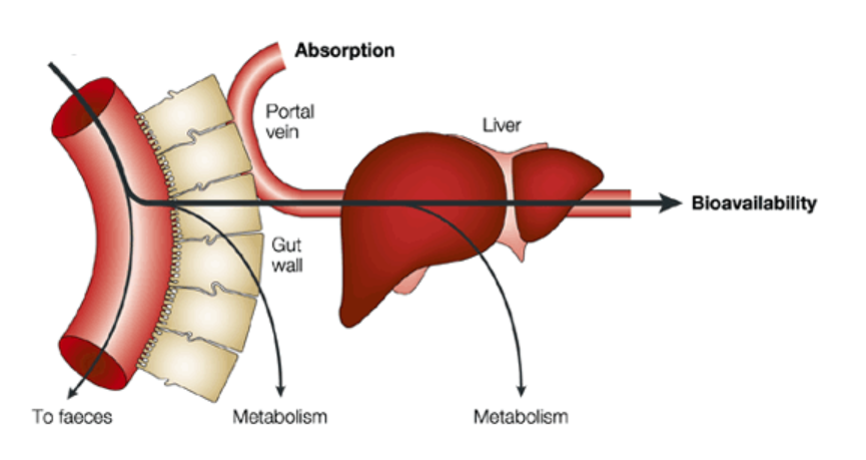5 Drugs and the liver
The liver metabolizes the majority of drugs administered orally and most that need to be metabolized to be excreted. This may involve activation or inactivation or drugs and making drugs water soluble so that they can be excreted.
First pass effect- The large reduction in concentration of an orally absorbed drug due to passage of the drug through the liver. Some drug will be lost during absorption from the intestine and more from metabolism in the liver. Remember, the liver sees many things as potential toxins and tries to detoxify them. Drugs are included in that list of things that the liver tries to remove.

Bioavailability– the fraction of the drug that escapes the liver and reaches the systemic circulation due to the first pass effect. If a drug is given intravenously, it is considered to have 100% bioavailability since it is all in the blood stream. The same drug given orally will have less bioavailability since some is never absorbed (stays in the gut and ends up in the feces) or is modified by the liver before it hits the vascular system.
Cytochromes P450 (CYPs) are hemeproteins used extensively by the liver to metabolize drugs. The types and amounts of CYPs vary by species, sex and genetic makeup. Changes in CYPs result in different levels of drug effectiveness and toxicity. Differences in cyp450 is responsible for the unique responses of horses and cats to certain drugs.
Drugs can interact with CYPs in 3 different ways.
- Drugs may just be metabolized by the CYPs. Generally this makes drugs less available to the animal as it leads to faster excretion.
- Drugs may inhibit CYP activity. Erythromycin and omeprazole inhibit CYP activity. This prevents the CYPs from metabolizing other drugs being administered to the animal, resulting in abnormally high levels of the unmetabolized drugs.
- Drugs may induce CYP activity. Phenytoin, phenobarbital, griseofulvin and rifampin are CYP inducers. When they are present, the CYPs metabolize other drugs at a much higher rate, resulting in low working levels of those drugs.
Obviously it is crucial to know the full list of drugs being administered in order to check for interactions. Consult with a pharmacist if unclear!
Liver disease and drugs
Drug administration needs to be carefully considered and monitored in animals with hepatic damage. Drugs can be more active or less active in an animal with liver disease.
When the liver metabolizes drugs, it can activate or inactivate drugs. With liver disease, drug may not be activated or deactivated as much as usual. Albumin binds active drug and keeps it from working. More active drug may be present in liver failure due to low albumin levels. The liver also conjugates drugs to excrete them. If it can’t conjugate properly, the drug builds up in the body.
Most antibiotics are metabolized by the liver. In humans with liver disease, care must be taken with sulfas and with clavulanic acid. Penicillins and cephalosporins are considered safe; regular doses of fluroquinolones and tetracyclines are also low risk.
Drugs can also damage or add to hepatic damage in three different ways :
- immune response to the drug / idiosyncratic reactions
- toxic metabolites that cause more damage
- interactions with cytokines activated by liver damage
Drugs that can cause more damage include clavamox, contraceptives and ibuprofen.
Resources
The liver -function – good focus on drugs and toxins
Cytochrome P450 – 1 page monograph
What are cytochrome P450 enzymes? – includes info on grapefruit juice
Inducers and inhibitors – video designed for med students

